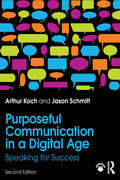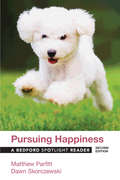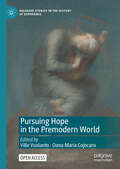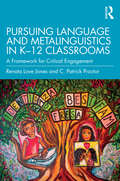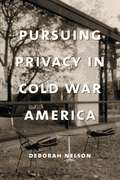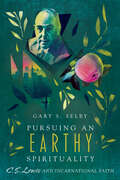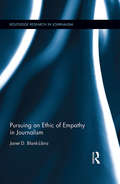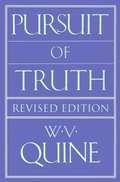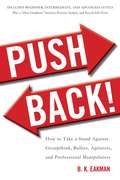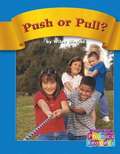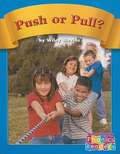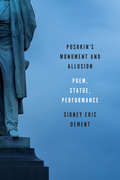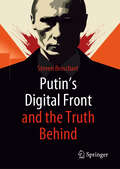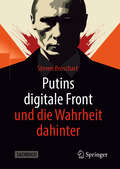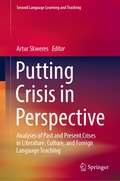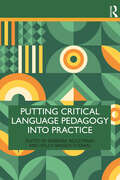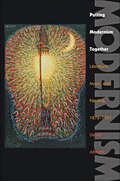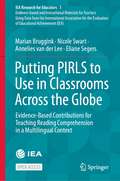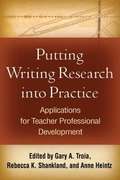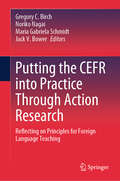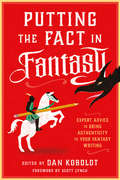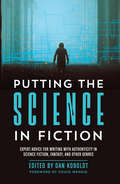- Table View
- List View
Purposeful Communication in a Digital Age: Speaking for Success
by Arthur Koch Jason SchmittIn recent years, the process and outlet for public speaking has grown with digital progressions such as TED talks and Facebook Live. Purposeful Communication in a Digital Age, 2nd Edition, provides a practical, step-by-step approach to developing and delivering effective speeches. Offering supplementary articles, case studies, and interviews with key leaders within the text and online, this is an all-in-one resource for the traditional, online, or hybrid classroom. The new edition devotes focus to presenting in the digital world, addressing both traditional and contemporary forms of presentation, and specifically directs students on seeking out credible sources when conducting research. Its eResource features video speech examples, classroom exercises, an instructor manual, and a quiz bank.
Purrieties of Language: How We Talk about Cats Online
by Edith PodhovnikAfter conquering the Internet, cats are now taking on linguistics! Since the advent of social media, cats have become a topic central to online communication, and the multitude of cat-related accounts now online has made this a world-wide phenomenon. Through cat-inspired varieties of language, we have developed a genre of cat-inspired vocabulary. And on our special social media accounts for our cats, we take on their identities, as we post, write, talk, and chat - as our feline friends. This innovative book provides linguistic analyses of the cyber 'Cativerse', exploring online language variation, and explaining key linguistic concepts – all through the lens of cat-related communication. Each chapter explores a different sociolinguistic phenomena, drawing on fun and engaging examples including memes, hashtags, captions and 'LOLcats', from platforms such as Instagram, Facebook, YouTube and Twitter. Innovative yet accessible, it is catnip for all 'hoomans' interested in how language is used online.
Pursuing Happiness: A Bedford Spotlight Reader
by Matthew Parfitt Dawn SkorczewskiPursuing Happiness: A Bedford Spotlight Reader explores questions around the central concept of what makes us happy: What is the psychology of happiness? Can we make or buy our own happiness? How should we question what makes us happy? How can we make ourselves and others happy? Does technology make us happy? Readings by philosophers, psychologists, spiritual leaders, ethicists, economists, and others take up these issues and more. Questions and assignments for each selection provides a range of activities for students. The catalog page for the titles in the Spotlight Series offers comprehensive instructor support with sample syllabi and additional teaching resources.
Pursuing Hope in the Premodern World (Palgrave Studies in the History of Experience)
by Ville Vuolanto Oana-Maria CojocaruThis open access book provides the first scholarly account of the role of hope and hopefulness from the perspective of social and cultural life in ancient, medieval and early modern societies. This edited collection brings together fourteen chapters based on case-studies from its contributors, along with a theoretical chapter that serves as the introduction. Throughout history, people have gone on with their lives despite many kinds of trials and tribulations. In this, hope, understood as a future-oriented positive disposition, has been a major driving force to manage uncertainty, mitigate despair, and to give meaning to living. This book analyzes these life situations and changing responses to them in the context of hope and futurity in a longue durée perspective.
Pursuing Language and Metalinguistics in K–12 Classrooms: A Framework for Critical Engagement
by C. Patrick Proctor Renata Love JonesThis conceptually expansive volume provides a theoretical framework and practical guide for designing and implementing literacy instruction that promotes students’ critical metalinguistic awareness in K–12 classroom contexts.Grounded in varied instructional contexts, the chapters present theories of language and overviews of research in ways that are accessible and engaging. Through innovative research and practical examples, the authors show how educators can address content areas, modalities, and K–12 student populations in increasingly diverse classroom spaces.Concrete instructional examples throughout, along with a culminating set of teacher vignettes, make this text an invaluable resource for pre-service teachers, graduate students, and scholars in the field of literacy education.
Pursuing Privacy in Cold War America (Gender and Culture Series)
by Deborah NelsonPursuing Privacy in Cold War America explores the relationship between confessional poetry and constitutional privacy doctrine, both of which emerged at the end of the 1950s. While the public declarations of the Supreme Court and the private declamations of the lyric poet may seem unrelated, both express the upheavals in American notions of privacy that marked the Cold War era. Nelson situates the poetry and legal decisions as part of a far wider anxiety about privacy that erupted across the social, cultural, and political spectrum during this period. She explores the panic over the "death of privacy" aroused by broad changes in postwar culture: the growth of suburbia, the advent of television, the popularity of psychoanalysis, the arrival of computer databases, and the spectacles of confession associated with McCarthyism.Examining this interchange between poetry and law at its most intense moments of reflection in the 1960s, '70s, and '80s, Deborah Nelson produces a rhetorical analysis of a privacy concept integral to postwar America's self-definition and to bedrock contradictions in Cold War ideology. Nelson argues that the desire to stabilize privacy in a constitutional right and the movement toward confession in postwar American poetry were not simply manifestations of the anxiety about privacy. Supreme Court justices and confessional poets such as Anne Sexton, Robert Lowell, W. D. Snodgrass, and Sylvia Plath were redefining the nature of privacy itself. Close reading of the poetry alongside the Supreme Court's shifting definitions of privacy in landmark decisions reveals a broader and deeper cultural metaphor at work.
Pursuing Privacy in Cold War America (Gender and Culture Series)
by Deborah NelsonPursuing Privacy in Cold War America explores the relationship between confessional poetry and constitutional privacy doctrine, both of which emerged at the end of the 1950s. While the public declarations of the Supreme Court and the private declamations of the lyric poet may seem unrelated, both express the upheavals in American notions of privacy that marked the Cold War era. Nelson situates the poetry and legal decisions as part of a far wider anxiety about privacy that erupted across the social, cultural, and political spectrum during this period. She explores the panic over the "death of privacy" aroused by broad changes in postwar culture: the growth of suburbia, the advent of television, the popularity of psychoanalysis, the arrival of computer databases, and the spectacles of confession associated with McCarthyism.Examining this interchange between poetry and law at its most intense moments of reflection in the 1960s, '70s, and '80s, Deborah Nelson produces a rhetorical analysis of a privacy concept integral to postwar America's self-definition and to bedrock contradictions in Cold War ideology. Nelson argues that the desire to stabilize privacy in a constitutional right and the movement toward confession in postwar American poetry were not simply manifestations of the anxiety about privacy. Supreme Court justices and confessional poets such as Anne Sexton, Robert Lowell, W. D. Snodgrass, and Sylvia Plath were redefining the nature of privacy itself. Close reading of the poetry alongside the Supreme Court's shifting definitions of privacy in landmark decisions reveals a broader and deeper cultural metaphor at work.
Pursuing an Earthy Spirituality: C. S. Lewis and Incarnational Faith
by Gary S. Selby"Red beef and strong beer" was how C. S. Lewis described his education under one of his early tutors. It was, in other words, a substantial education that engaged deeply with the intellectual tradition and challenged him to grow. Gary Selby sees Lewis's expression as an indication of the kind of transformation that is both possible and necessary for the Christian faith, and he contends that spiritual formation comes about not by retreating from the physical world but through deeper engagement with it. By considering themes such as our human embodiment, our sense of awareness in our everyday experiences, and the role of our human agency—all while engaging with the writings of Lewis, who himself enjoyed food, drink, laughter, and good conversation—Selby demonstrates that an earthy spirituality can be a robust spirituality.
Pursuing an Ethic of Empathy in Journalism (Routledge Research in Journalism)
by Janet Blank-LibraThis book advances a journalistic theory of empathy, challenging long-held notions about how best to do journalism. Because the institution of journalism has typically equated empathy and compassion with bias, it has been slow to give the intelligence of the emotions a legitimate place in the reporting and writing process. Blank-Libra’s work locates the point at which the vast, multidisciplinary research on empathy intersects with the work of the journalist, revealing a reality that has always been so: journalists practice empathy as a way to connect but also as a form of inquiry, as sincere and legitimate in its goals and aspirations as is objectivity.
Pursuit Of Truth
by W. V. QuineIn Pursuit of Truth W. V. Quine gives us his latest word on issues to which he has devoted many years. As he says in the preface: "In these pages I have undertaken to update, sum up, and clarify my variously intersecting views on cognitive meaning, objective reference, and the grounds of knowledge?'The pursuit of truth is a quest that links observation, theory, and the world. Various faulty efforts to forge such links have led to much intellectual confusion. Quine's efforts to get beyond the confusion begin by rejecting the very idea of binding together word and thing, rejecting the focus on the isolated word. For him, observation sentences and theoretical sentences are the alpha and omega ofthe scientific enterprise. Notions like "idea" and "meaning" are vague, but a sentence-now there's something you can sink your teeth into. <p><p> Starting thus with sentences, Quine sketches an epistemological setting for the pursuit of truth. He proceeds to show how reification and reference contribute to the elaborate structure that can indeed relate science to its sensory evidence.In this book Quine both summarizes and moves ahead. Rich, lively chapters dissect his major concerns-evidence, reference, meaning, intension, and truth. "Some points;' he writes, "have become clearer in my mind in the eight years since Theories and Things. Some that were already clear in my mind have become clearer on paper. And there are some that have meanwhile undergone substantive change for the better." This is a key book for understanding the effort that a major philosopher has made a large part of his life's work: to naturalize epistemology in the twentieth century. The book is concise and elegantly written, as one would expect, and does not assume the reader's previous acquaintance with Quine's writings. Throughout, it is marked by Quine's wit and economy of style.
Push Back!: How to Take a Stand Against Groupthink, Bullies, Agitators, and Professional Manipulators
by B. K. EakmanHow many times have you had the unsettling experience of being treated as a troublemaker as soon as you question or raise an objection to a school policy, a textbook, a course of study, a new county regulation, or a community proposal?Every day, attendees of conferences, community forums, PTA meetings, and board meetings are made to feel uncomfortable and occasionally foolish by the person or persons leading the meeting. The speakers, moderators, or provocateurs-whom author B. K. Eakman refers to as professional manipulators-hold power over the room and know how to steer the discussion back to their agendas without ever answering audience questions or addressing their concerns. These people use techniques to ostracize those brave enough to stand and question or criticize them.With Push Back!, readers will be able to counter group manipulation tactics by learning to:Recognize psychologically controlled environmentsIdentify the professional agitator/provocateurExamine components of psych warUndercut faulty, distorted, and biased arguments of opponentsSquelch techniques used to rebuff audience members who complain or balkNeutralize consensus-building techniquesAnd much more
Push Or Pull?
by Wiley BlevinsDiscusses forces such as push or pull in an easy-to-read text that incorporates phonics instruction and rebuses.
Push or Pull?
by Wiley BlevinsPhonics Readers is a recognized leader in helping you teach phonics and phonemic awareness, within the context of content-area reading. Content area focus: Pushes or Pulls Phonics Skills: long u (u_e, ew), inflectional ending -ed
Pushing the Boundaries of Latin American Testimony
by Louise Detwiler Janis BreckenridgeRevealing twenty-first century contexts, ground-breaking scenarios, and innovative mediums for this highly contested life writing genre, this volume showcases a new generation of testimonio scholarship.
Pushkin’s Monument and Allusion: Poem, Statue, Performance
by Sidney Eric DementIn August of 1836 Alexander Pushkin wrote a poem now popularly known simply as "Monument." He died a few months later in January of 1837. In the decades following his death, the poem "Monument" was transformed into a statue in central Moscow: the Pushkin Monument. At its dedication in 1880, the interaction between the verbal text and the visual monument established a creative dynamic that subsequent generations of artists and thinkers amplified through the use of allusion, the aesthetic device by which writers reference select elements of cultural history to enrich the meaning of their new creation and invite their reader into the shared experience of a tradition. The history of the Pushkin Monument reveals how allusive practice becomes more complex over time. By the twentieth century, both writers and readers negotiated increasingly complex allusions not only to Pushkin’s poem, but to its statuesque form in Moscow and the many performances that took place around it. As the population of newly literate Russians grew throughout the twentieth century, images of the future poet and the naive reader became crucial signifiers of the most meaningful allusions to the Pushkin Monument. Because of this, the story of Pushkin’s Monument is also the story of cultural memory and the aesthetic problems that accompany a cultural history that grows ever longer as it moves into the future.
Putin's Digital Front and the Truth Behind
by Steven BroschartPutin's war in Ukraine is not only fought on the battlefield. Combat also occurs on the digital front. Words and information are the ammunition of modern, hybrid warfare—against the opposing military, but especially against civilians. It is about manipulation and control. About confusion and distraction from what is really happening. However, the internet is used not only for propaganda but also for intelligence and logistics. In doing so, Russia leaves behind a lot of traces. Analyst Steven Broschart demonstrates in clear language that requires no prior knowledge which psychological and communicative means are employed at Putin's digital frontline.
Putins digitale Front und die Wahrheit dahinter
by Steven BroschartPutins Krieg in der Ukraine wird nicht nur auf dem Schlachtfeld ausgetragen. Gekämpft wird auch an der digitalen Front. Worte und Informationen sind die Munition der modernen, der hybriden Kriegsführung - gegen das gegnerische Militär, aber insbesondere gegen Zivilisten. Es geht um Manipulation und Kontrolle. Um Verwirrung und Ablenkung von dem, was wirklich geschieht. Doch das Internet wird nicht nur zur Propaganda, sondern auch für die Aufklärung und die Logistik genutzt. Und dabei hinterlässt Russland eine Menge Spuren. Analyst Steven Broschart zeigt konkret, welche psychologischen und kommunikativen Mittel an Putins digitaler Frontlinie zum Einsatz kommen.
Putting Crisis in Perspective: Analyses of Past and Present Crises in Literature, Culture, and Foreign Language Teaching (Second Language Learning and Teaching)
by Artur SkweresThis collected book analyzes the phenomenon of crisis manifested across various historical periods. It offers unique, multifaceted, and interdisciplinary perspectives on the issues of crises and finds numerous applications in the fields of literature, linguistics, advertising, photography, and foreign language teaching. The collection is divided into two parts. The chapters in its first part analyze literature and language: from medieval England to cultural changes in America occurring under the influence of the transformation caused by the propagation of print culture. The incisive commentaries consider the works of culture that span not only literature but also film. They reveal how much we can learn by considering how past generations perceived reality in times of crisis. The second part of the book contains chapters, which examine texts related to contemporary crises expressed in the visual media of advertising and photography, but also in foreign language teaching. As the authors show, both ads and non-commercial, socially engaged photographs can influence the viewer in a swift and impactful manner by conveying messages of great social importance. The authors convincingly that argue both photographs and ads can be used for social benefit by visualizing even the unpleasant or shocking sides of reality. Finally, the notion of crisis experienced by students of English as a foreign language is analyzed and supplemented by research which may prove useful for researchers and practitioners alike.
Putting Critical Language Pedagogy into Practice
by Holly Hansen-Thomas Barbara MuszyńskaPutting Critical Language Pedagogy into Practice explores the practice of language teaching through the lens of critical pedagogy, reflexivity, and the importance of reflexivity for teacher development. It also shows how these reflexive practices can contribute to more inclusivity and decolonization of the curriculum. A range of experts argue persuasively for epistemological reflexivity in practice and demonstrate how to implement this critical thinking into daily instructional practice. Each chapter is structured around three themes in order to help readers connect challenging theoretical ideas into day to day teaching practice: Reflection – the author’s story and issue of concern; Epistemic Reflexivity – personal epistemologies reflecting on the social conditions influencing the theory underpinning that author’s practices; Resolved action – how the epistemic reflexivity leads to purposeful decision-making enacted in classroom contexts. Original, thoughtful and challenging, this text is fascinating and instructional reading for language education advanced students, researchers and practitioners. The idea for this book emerged during the Fulbright scholarship at Texas Woman’s University out of the mutual research interests of the editors.
Putting Modernism Together: Literature, Music, and Painting, 1872–1927 (Hopkins Studies in Modernism)
by Daniel AlbrightA powerful introduction to modernism and the creative arts it inspired.How do you rationally connect the diverse literature, music, and painting of an age? Throughout the modernist era—which began roughly in 1872 with the Franco-Prussian War, climaxed with the Great War, and ended with a third catastrophe, the Great Depression—there was a special belligerence to this question. It was a cultural period that envisioned many different models of itself: to the Cubists, it looked like a vast jigsaw puzzle; to the Expressionists, it resembled a convulsive body; to the Dadaists, it brought to mind a heap of junk following an explosion. In Putting Modernism Together, Daniel Albright searches for the center of the modernist movement by assessing these various artistic models, exploring how they generated a stunning range of creative work that was nonetheless wound together aesthetically, and sorting out the cultural assumptions that made each philosophical system attractive. Emerging from Albright's lectures for a popular Harvard University course of the same name, the book investigates different methodologies for comparing the evolution and congruence of artistic movements by studying simultaneous developments that occurred during particularly key modernist years. What does it mean, Albright asks, that Joseph Conrad's Heart of Darkness, published in 1899, appeared at the same time as Claude Debussy's Nocturnes—beyond the fact that the word "Impressionist" has been used to describe each work? Why, in 1912, did the composer Arnold Schoenberg and the painter Vassily Kandinsky feel such striking artistic kinship? And how can we make sense of a movement, fragmented by isms, that looked for value in all sorts of under- or ill-valued places, including evil (Baudelaire), dung heaps (Chekhov), noise (Russolo), obscenity (Lawrence), and triviality (Satie)? Throughout Putting Modernism Together, Albright argues that human culture can best be understood as a growth-pattern or ramifying of artistic, intellectual, and political action. Going beyond merely explaining how the artists in these genres achieved their peculiar effects, he presents challenging new analyses of telling craft details which help students and scholars come to know more fully this bold age of aesthetic extremism.
Putting PIRLS to Use in Classrooms Across the Globe: Evidence-Based Contributions for Teaching Reading Comprehension in a Multilingual Context (IEA Research for Educators #1)
by Marian Bruggink Nicole Swart Annelies van der Lee Eliane SegersThis open access book provides teachers with approaches to strengthen reading comprehension instruction based on scientific research and evidence-based didactic principles. In this volume, the Progress in International Reading Study (PIRLS) framework is used to inform teachers about the skills and knowledge that students need to comprehend certain texts. The book gives practical guidance on how a teacher can help students to learn these skills, specifically, when teaching reading to multilingual students. Good practices from schools in five participating PIRLS countries—Chile, Chinese Taipei, England, Georgia, and Spain—are shared. A description of the schools’ education in reading comprehension is provided with practical tips and example lessons. These insights into daily reading education in multilingual classrooms across the globe can be an inspiration to teachers all over the world.
Putting Writing Research into Practice
by Rebecca Shankland Gary TroiaWhat are the most effective methods for teaching writing across grade levels and student populations? What kind of training do teachers need to put research-validated methods into practice? This unique volume combines the latest writing research with clear-cut recommendations for designing high-quality professional development efforts. Prominent authorities describe ways to help teachers succeed by using peer coaching, cross-disciplinary collaboration, lesson study, and other professional development models. All aspects of instruction and assessment are addressed, including high-stakes writing assessments, applications of technology, motivational issues, writing in different genres and subject areas, and teaching struggling writers.
Putting the CEFR into Practice Through Action Research: Reflecting on Principles for Foreign Language Teaching
by Noriko Nagai Gregory C. Birch Jack V. Bower Maria Gabriela SchmidtThis book provides an overview of an action research model which utilizes the Common European Framework of Reference for Languages (CEFR) and stresses the importance of systematically researching classroom practice. It introduces the complementary nature of the CEFR and action research, the CEFR, and the CEFR-focused Action Research Model (CARM). The book includes seven case studies guided by the model and concludes with an overall assessment of the efficacy of the CARM as a way to facilitate action research into CEFR-informed practice. Undertaken in a Japanese educational context, the focus of the book is squarely on classroom-based CEFR-focused action research concerning issues that all educators face, such as course design, materials development/selection, classroom implementation, learner autonomy and assessment.
Putting the Fact in Fantasy: Expert Advice to Bring Authenticity to Your Fantasy Writing
by Scott Lynch Dan KoboldtA collection of essays from historians, linguists, martial artists, and other experts to help you write more compelling fantasy by getting the facts rightWhether it's correctly naming the parts of a horse, knowing how lords and ladies address one another, or building a realistic fantasy army, getting the details right takes fantasy writing to the next level. Featuring some of the most popular articles from Dan Koboldt&’s Fact in Fantasy blog as well as several never-before-seen essays, this book gives aspiring and established fantasy writers alike an essential foundation to the fascinating history and cultures of our own world, which serve as a jumping-off point for more inspired and convincing fantasy.
Putting the Science in Fiction: Expert Advice for Writing with Authenticity in Science Fiction, Fantasy, & Other Genres
by Chuck Wendig Dan KoboldtScience and technology have starring roles in a wide range of genres--science fiction, fantasy, thriller, mystery, and more. Unfortunately, many depictions of technical subjects in literature, film, and television are pure fiction. A basic understanding of biology, physics, engineering, and medicine will help you create more realistic stories that satisfy discerning readers. This book brings together scientists, physicians, engineers, and other experts to help you:Understand the basic principles of science, technology, and medicine that are frequently featured in fiction.Avoid common pitfalls and misconceptions to ensure technical accuracy.Write realistic and compelling scientific elements that will captivate readers.Brainstorm and develop new science- and technology-based story ideas.Whether writing about mutant monsters, rogue viruses, giant spaceships, or even murders and espionage, Putting the Science in Fiction will have something to help every writer craft better fiction.Putting the Science in Fiction collects articles from "Science in Sci-fi, Fact in Fantasy," Dan Koboldt's popular blog series for authors and fans of speculative fiction (dankoboldt.com/science-in-scifi). Each article discusses an element of sci-fi or fantasy with an expert in that field. Scientists, engineers, medical professionals, and others share their insights in order to debunk the myths, correct the misconceptions, and offer advice on getting the details right.
